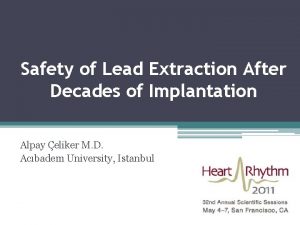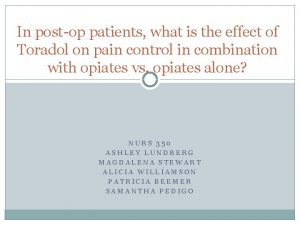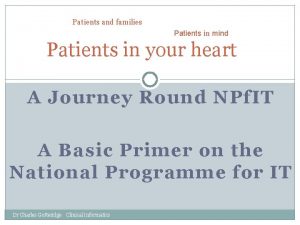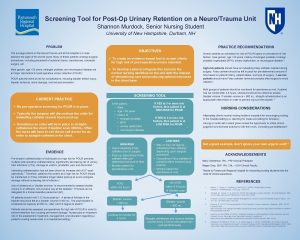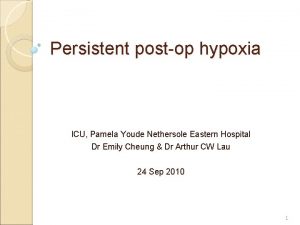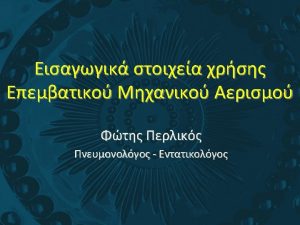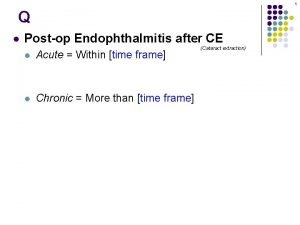In postop patients what is the effect of













- Slides: 13

In post-op patients, what is the effect of Toradol on pain control in combination with opiates vs. opiates alone? NURS 350 ASHLEY LUNDBERG MAGDALENA STEWART ALICIA WILLIAMSON PATRICIA BEEMER SAMANTHA PEDIGO

Introduction Adequate post operative pain control is important for successful patient outcomes. Poor pain control can result in immobility, stiffness, myocardial ischemia, pneumonia, anxiety, depression and chronic pain. Patients with good pain control tend to recover faster and are being discharged from hospital sooner.

�Traditional approach focused on the use of opioid analgesic for post operative pain management, mainly patient controlled analgesia (PCA). �The use of PCA have been associated with over sedation, constipation, confusion, urinary retention, nausea and vomiting. �There is a need to focus on better pain control with fewer side effects and complication. �The focus of this presentation is on the use of multimodal pain management.

Literature Review �There a number of articles that have a good amount of evidence to support multimodal pain management. �Each of these articles include information regarding pain medication that is often used post-operatively: Opiates NSAIDs Acetaminophen

Literature Review Cont. �The articles compare previous pain relief methods (using only patient controlled analgesia, epidural analgesia, and parenteral narcotics) to the use of multimodal analgesia. �Main areas of study in each article: Amount of pain relief achieved with narcotics and NSAIDs (Toradol) given together and separately Patient satisfaction Side effects of medication Patient outcomes

Literature Review Cont. �The main type of surgical procedure that the authors focus on is orthopedic surgery This type of surgery is often very painful Pain is often poorly controlled Until recently, there has been little research done regarding different ways to treat post-op pain (Nett, 2010). �Issues that researchers have run into: Subjectivity of pain (each person rates it differently) Sample sizes used in studies have been too small Reluctance of some to move away from narcotic analgesia

Analysis of the evidence �The research articles present existing evidence on the use of Toradol in postoperative pain management. o Toradol has been used in orthopedic, gynecologic, abdominal and oral surgeries for control of moderate to severe pain. o Several studies have compared the use of Toradol alone with opioid analgesics. o Short term use of Toradol (up to 5 days) has low incidence of side effects. o The use of Toradol alone does not provide adequate pain control when compared to the use of opiates.

Analysis of evidence Cont. �The new evidence: o Adding NSAIDs to the opioid treatment reduces morphine requirements. o Use of Toradol with opiates results in decrease in opioid-related side effects including pruritus. o Research shows that there was no difference in incidence of nausea and vomiting when Toradol was used in combination with opiates. o Non-opioid management of pain may increase with the increased number of minimally invasive surgeries. �Limitations: o Short window of observation (before mobilizing the patients) o No data was gathered on toxicity of repeated administration of NSAIDs during one of the studies (Cepeda et al, 2005)

Application of Evidence � Toradol – first approved parenteral NSAID in the US ((Lassen et al, 1992) � Opioid-Sparing drug by minimizing side effects and decreasing need for opiate use (Lassen et al, 1992) Nursing Preference: Better pain control, increased patient satisfaction and outcomes. � NSAID incorporation has led to less opiate consumption which further results in less adverse effects. � Fewer side effects and adequate pain management = shortened hospital stays and positive patient outcomes � Patient Preference: Can be compared to effectiveness of Morphine. Toradol can provide sustained relief for a duration of approximately 5 -6 hours without side effects such as sedation, nausea/vomiting, & ileus formation (Lassen et al, 1992). � Increased satisfaction due to early mobilization, less adverse effects, proper pain management and control, and less risk for further complications �

Application of Evidence � Barriers: Contraindications to Toradol usage � Angioedema, Bronchospasms, Other NSAID Use, Renal Failure, Bleeding Disorders (Lassen et al, 1992) Surgeon Preference � Some surgeons stray away from the use of a NSAID due to concern over bone re-growth or joint loosening, however according to studies NSAIDS do not affect in-growth (Nett, 2010) � Bridges: Patient Education � Early Mobilization � Educating Patient on inadequate pain relief and continuing pain medications at home following surgery (Elvir-Lazo, O. & White, P, 2010) Toradol alone and/or combination with opioid use has a significant impact on early mobilization related to proper pain management, can shorten length of stays, and prevent further complications Bridging Toradol with Other Pain Relievers � � � Utilizing Opioids, Nerve Blockades, Acetaminophen along with NSAIDS to ensure adequate pain control (Nett, 2010) The use of multimodal pain relief has allowed nurses to become more aware of the significance of pain control measures, patient satisfaction, and outcomes. Goal being to reduce narcotic requirements, restore prior function, improve pain control, and to lessen adverse effects

Application of Evidence � Nurses & Physicians play a vital role in assessing and managing each patient’s pain control, interventions provided, the effects of the treatments, and communication of pain control plan � Evidence of Treatments Provided on an Orthopedic Unit & Adequate Influence to Utilize Evidence Higher Pain Control Rates of those combining Toradol along with Opioid use i. e. Oxycodone and the use of Peripheral Nerve Blocks Early Mobilization: Patients dangling at bedside or sitting in chair day of surgery which in turn decreases the prevalence of a DVT and Pneumonia Less Side Effects: Patients are less sedated, cardiac & respiratory statuses not affected which in turn has less effect on early mobilization, and nausea is rarely present Patients are receiving longer duration of pain control through the use of Toradol and oral narcotics versus the short half life of Dilaudid and Morphine Shortened Length of Stays: Patients are discharging as scheduled versus prolonged stays due to inadequate pain relief Increased Patient Satisfaction: Patients are satisfied with hospital stay as less adverse effects are present, pain control is adequate, and mobilization goals are met

Recommendation of findings � Consensus among researchers seems to indicate that a multimodal approach to pain management following surgery is necessary to improve overall patient satisfaction � Improved pain management increases patient satisfaction, improved patient outcomes in terms of mobility and decreases in chronic pain, and shorter hospital stays (decreases chances for infection) � Multimodal approaches usually include combination of an NSAID such as Toradol with patient-controlled analgesia of opiate product such as Morphine � A multimodal approach to pain management that includes an NSAID and an opiate should become a routine among physicians and hospitals to increase patient satisfaction, decrease length of hospital stay, improve mobility, reduce side effects of opioid therapy and bed rest; including constipation, pneumonia, opiate tolerance, and depression, and decrease likelihood of chronic pain � Additional research is needed to further evaluate the value and side effect profiles of Toradol used in combination with opiates

References � Cepeda, M. , Carr, D. , Miranda, N. , Diaz, A. , Silva, C. , Morales, O. (2005). Comparison of morphine, ketorolac, and their combination for postoperative pain. Anesthesiology, 103(6), 1225– 1232 � Elvir-Lazo, O. & White, P. (2010)Postoperative pain management after ambulatory surgery: role of multimodal analgesia. Anesthesiology Clinics, 28, 217 -224. doi: 10. 1016/j. anclin. 2010. 02. 011 � Lassen, K. , Epstein-Stiles, M. , Olsson, G. (1992). Ketorolac: a new parenteral nonsteroidal anti-inflammatory drug for postoperative pain management. Journal of Post Anesthesia Nursing, 7(3), 238 -242. � Nett, M. (2010). Postoperative pain management. Orthopedics, 33(9) doi: 10. 3928/01477447 -20100722 -60
